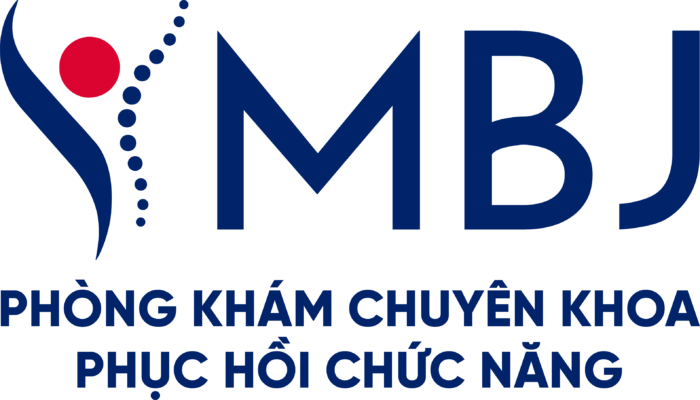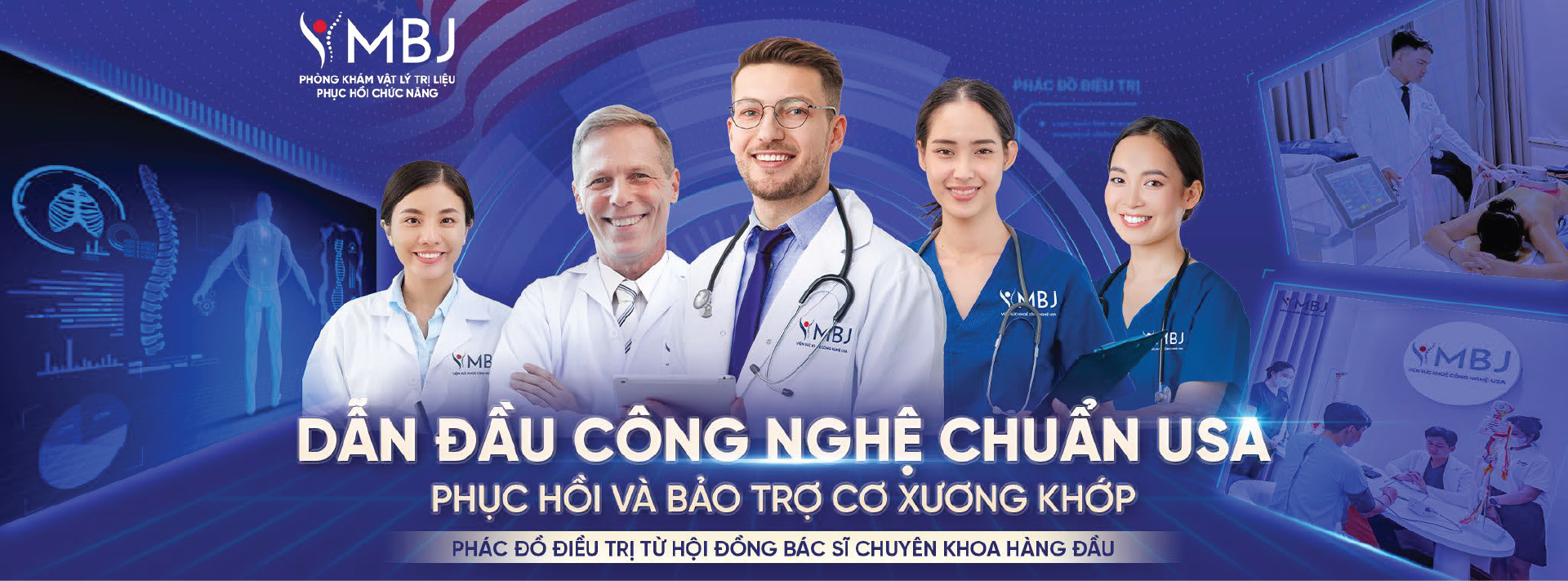The hip joint is one of the largest and most important joints in the body, responsible for supporting nearly our entire body weight and allowing for complex movements like walking, standing, running, and jumping. However, as the hip joint “ages,” a condition known as hip osteoarthritis can occur, causing chronic pain and severely impacting mobility and quality of life.
Early recognition of symptoms and proper treatment, especially physical therapy, are key to slowing the disease’s progression, reducing pain, and preserving motor function. This article, with professional consultation from the team of experts at MBJ Physical Therapy Clinic, will provide you with a comprehensive overview of this condition.
Nội dung
I. What is Hip Osteoarthritis?
Hip Osteoarthritis is a chronic degenerative condition that occurs when the articular cartilage, which covers and protects the femoral head and the acetabulum (hip socket), wears down, cracks, and deteriorates over time.
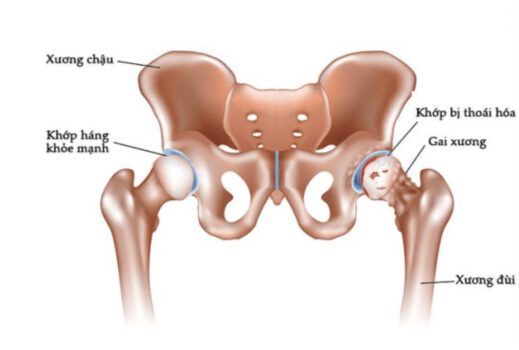
Mechanically, you can think of cartilage as a rubbery cushion between the two ends of the bones. When this cushion thins or disappears, the space between the bones narrows. They then rub directly against each other with movement, causing symptoms like pain, inflammation, and stiffness. Over time, the body may react by forming bone spurs (osteophytes) around the joint’s edge, further worsening the condition.
II. Typical Symptoms of Hip Osteoarthritis
The symptoms of the disease usually develop slowly and worsen over time. Early recognition of the following signs is crucial:
- Aching Pain: This is the most prominent symptom. The pain often occurs in the groin or the front of the thigh. Sometimes, the pain can radiate to the buttocks, the back of the thigh, or even the knee (referred pain).
- Nature of the Pain: The pain is typically “mechanical,” meaning it worsens with activity (especially walking, standing up from a sitting position, turning, or climbing stairs) and improves significantly with rest.
- Stiffness: A feeling of stiffness in the hip joint in the morning after waking up or after sitting for a long time. This stiffness usually lasts less than 30 minutes.
- Limited Range of Motion: Patients find it very difficult to perform movements requiring hip flexibility, such as abduction (moving the leg out to the side), internal or external rotation. Daily activities like squatting, putting on socks, cutting toenails, or tying shoelaces can become nearly impossible.
- Changes in Gait: To alleviate pain, patients tend to limp, shifting their weight to the healthy leg.
- Grinding Sensation: Some people may hear or feel a clicking, popping, or grinding sensation (crepitus) within the joint during movement.
III. Causes and Risk Factors for Hip Osteoarthritis
Hip osteoarthritis can be classified as primary (no known cause, often due to aging) or secondary (due to a specific cause). Major risk factors include:
- Age: This is the leading risk factor. Cartilage gradually loses its elasticity and ability to repair as we get older.
- Mechanical Factors:
- Overweight and Obesity: The greater the body weight, the more pressure is placed on the hip joint, accelerating cartilage wear.
- Heavy Labor: Jobs that require heavy lifting, prolonged standing, or high-impact, repetitive sports (marathon running, weightlifting) increase the risk.
- History of Injury: Previous injuries to the hip area, such as a femoral neck fracture or hip dislocation, can alter the joint’s structure and lead to premature osteoarthritis.
- Underlying Medical Conditions:
- Avascular Necrosis of the Femoral Head: A lack of blood supply causes the femoral head to die, collapse, and destroy the joint surface.
- Congenital Hip Abnormalities: Such as congenital hip dysplasia or dislocation.
- Chronic Inflammatory Arthritis: Rheumatoid arthritis, ankylosing spondylitis, etc.
- Genetics: Family history also plays a role in the risk of developing the disease.
IV. How is Hip Osteoarthritis Diagnosed?
For an accurate diagnosis, doctors combine a physical examination with diagnostic imaging methods.
- Clinical Examination: The doctor will ask detailed questions about your symptoms (pain location, nature, timing), medical history, and past injuries. They will then directly examine the hip’s range of motion, identify painful points, and assess your gait.
- Diagnostic Imaging:
- X-ray: This is the first-line, most common, and effective imaging method. An X-ray can reveal classic signs of osteoarthritis, such as joint space narrowing, subchondral sclerosis (bone hardening), bone spurs, and cysts.
- Magnetic Resonance Imaging (MRI): Ordered in more complex cases or when a detailed assessment of the cartilage, subchondral bone, and surrounding soft tissues (tendons, muscles, ligaments) is needed, especially if avascular necrosis is suspected.
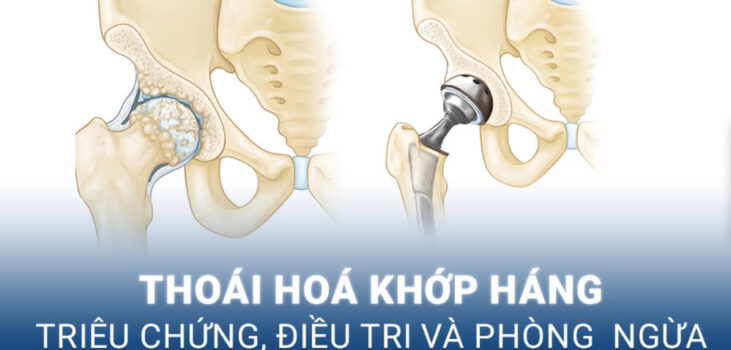
V. Effective Treatment Methods for Hip Osteoarthritis
The goals of treatment are to relieve pain, improve motor function, and slow the progression of the disease. Treatment is divided into two main categories: conservative and surgical.
1. Conservative (Non-Surgical) Treatment – The First Priority
This is the foundational and always-preferred approach, especially in the early to moderate stages of the disease.
- Lifestyle Modification: Weight loss, using assistive devices like a cane, and avoiding painful activities.
- Physical Therapy: This is the primary “weapon” in conservative treatment, helping patients regain function without drugs or surgery. The program includes specialized exercises (aquatic therapy, stationary cycling, stretching, strengthening) and therapeutic modalities (heat, electrical stimulation, ultrasound, joint mobilization).
- Medication (As prescribed by a doctor): Pain relievers, non-steroidal anti-inflammatory drugs (NSAIDs), and intra-articular injections.
2. Surgical Treatment (When Conservative Treatment Fails)
Surgery is considered when conservative methods are no longer effective. Options include hip arthroscopy, osteotomy, and hip replacement (partial or total).
VI. Effective, Non-Surgical Hip Osteoarthritis Treatment at MBJ Clinic
In Thu Dau Mot, MBJ Physical Therapy and Rehabilitation Clinic is proud to be a pioneering unit that has successfully treated thousands of hip osteoarthritis patients, helping them rediscover the joy of movement without drugs, injections, or surgery.
The MBJ difference comes from our superior American-standard protocol, which focuses on resolving the root cause of the disease:
- 1-on-1 Consultation with a Council of Specialists: From the very beginning, our Council of Musculoskeletal Specialists will directly examine and accurately diagnose your condition and degree of osteoarthritis to build a treatment plan “tailor-made” just for you.
- Addressing the Root Cause, Non-Invasively: We combine modern medicine with hands-on Physical Therapy by experts and High-Tech Therapy, delivering outstanding pain and inflammation relief that patients can feel from the very first session.
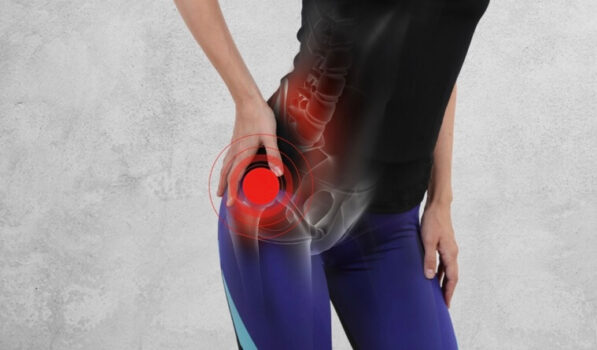
- State-of-the-Art, 100% Imported Equipment: MBJ invests heavily in world-leading technologies to accelerate the healing and recovery process:
- Shockwave Therapy: Breaks down calcifications and bone spurs, promoting cartilage tissue regeneration.
- High-Intensity Laser Therapy: Penetrates deep to the cellular level to help reduce pain, fight inflammation, and stimulate healing.
- Tecar Therapy: Enhances blood circulation, delivering oxygen and nutrients to nourish the hip joint.
- Effective Prevention of Recurrence: The treatment protocol is completed with proprietary Rehabilitation exercises. These exercises not only help restore range of motion and strengthen muscles to protect the hip joint but also effectively prevent the risk of pain returning.
VII. Frequently Asked Questions (FAQ)
- Can hip osteoarthritis be cured? Hip osteoarthritis is a chronic condition and cannot be completely cured. However, proper treatment can control symptoms very well, slow the disease’s progression, and help patients maintain a nearly normal life.
- How should I sleep with hip osteoarthritis? You should sleep on your back or on your side, on the non-painful leg. If sleeping on your side, place a thin pillow between your knees to keep the hip joint in a neutral position.
- Is the cost of treating hip osteoarthritis expensive? The cost depends on the method. Conservative treatment with physical therapy is often affordable. The cost of hip replacement surgery is significantly higher.
- What should I avoid with hip osteoarthritis? Avoid activities that put high stress on the joint, such as squatting, running, jumping, and heavy lifting. Limit processed foods, sugar, and saturated fats.
- Should I walk if I have hip osteoarthritis? Yes, but you must do it correctly on flat surfaces for a moderate duration. If it causes pain, switch to lower-impact sports like cycling or swimming.
- What should I eat to support hip osteoarthritis? Increase your intake of foods rich in Omega-3 (salmon), Calcium (milk, dark green vegetables), and antioxidant-rich fruits and vegetables.
- What happens if hip osteoarthritis is not treated? If left untreated, the pain will become constant, the joint will become increasingly stiff and deformed, leading to muscle atrophy, loss of mobility, and potentially the need for a wheelchair.
- What makes physical therapy at MBJ different? At MBJ, we apply a “3-in-1” treatment method: combining hands-on techniques, high-tech machinery, and a customized exercise program to deeply address the root cause of the disease for sustainable results.
Conclusion
Hip osteoarthritis is a challenge, but it is not the end of an active life. Understanding the disease, recognizing symptoms early, and proactively seeking modern treatment methods are essential. Among them, Physical Therapy and Rehabilitation play a backbone role, helping patients relieve pain and improve mobility safely and effectively.

 Tiếng Việt
Tiếng Việt